
Other
10 misconceptions on how to work with an archviz studio
Foreword for archviz audience
This article is first and foremost addressed to architecture firms, property developers or whatever types of clients we work with on a daily basis (hence why I'm hoping to get it published on architecture media). As in my previous article, the idea is to tackle common misconceptions that undermine the quality of the work we do as collaborators, in order to foster better communication and, down the line, better deliverables. I'd love to get your opinion and experience insight on the topic.
This article is first and foremost addressed to architecture firms, property developers or whatever types of clients we work with on a daily basis (hence why I'm hoping to get it published on architecture media). As in my previous article, the idea is to tackle common misconceptions that undermine the quality of the work we do as collaborators, in order to foster better communication and, down the line, better deliverables. I'd love to get your opinion and experience insight on the topic.
Introduction
The more I work with architects and property developers the more I've noticed biases in the way they understand what visualization studio services are actually about. I myself am an architect and can't help to see how similar this situation is to architects trying to explain their role to their own end clients.
It thus becomes all the more curious to me that their frustration doesn't translate in a better understanding of their own contractors.
With this article I'm trying to pinpoint common misconceptions architects tend to have when hiring archviz studios, and clarify what this collaboration is actually about. For the sake of keeping it short, I trimmed the list at the tenth item.
1. Portfolio is not the only thing that matters
Although what you're paying for is, generally, an image or a series of images, the portfolio should only be a first screening of candidates for collaboration.
We often simplify the rendering process to the pressing of a button, but there's a little bit more to that.
Even though the visual style of the studio you're working with should appeal to you, the fit is more a question of workflow, approach and how you can both work together successfully. Because, down the line, you won't get the visuals you're after or the best out of the studio if your mindsets didn't align properly.
2. Visualization is an investment, not an expense
It is understandable that any firm tries to cut cost where it is possible, but cutting cost on visualization is a really short term approach and poor maximization of resources. Just like designing without hiring an architect can often be for a layperson.
While the cost of images for competition can sometimes seem high, it is important to understand that these images, beyond being often compulsory for your competition submission, are also an integral part of your online presence and overall marketing.
Every competition, whether won or lost, is an opportunity to build a stronger portfolio with striking visuals that fit with the quality of the architecture you're doing. While the importance of visuals is highly debated among architects, clients are far away from these concerns and will always be more prone to like nice renderings rather than a nice set of plans, and definitely more prone to like nice renderings over bad cheap ones.
This portoflio of unbuilt works is particularly important for younger firms who haven't had the opportunity to put together built references yet.
Therefore, getting right your visual communication by finding the right studio(s) and investing in it will not only increase the chance of winning competitions, but also increase the reach and conversion rate of your communication on potential clients, which in turns will mean more projects, and more money, making this first investment profitable, manyfold.
3. Don't micromanage your contractors
In the same way that the last thing you want your client to do is to explain you where you should place a door to enter your appartment project but rather to give you broader concepts, ideas, and constraints to work from and trust you with the result, archviz studios generally only ask for the same and nothing else.
If you've chosen a specific studio or freelancer because you like their portfolio and the way they work, the last thing you want to do is to start micromanaging the way they work to the point of deteriorating the final deliverable quality. This kind of relates to what some calls the Project Perfection Syndrome where micro subjective changes will drain time (according to a Pareto distribution) and not be rewarding, or even seen, for anyone but the architect's ego.
One should rather treat these exchanges as collaboration and accept that sometimes it is in your best interest to rely on the expertise of others and grant them creative freedom within the constraints of the broad boundaries you've set.
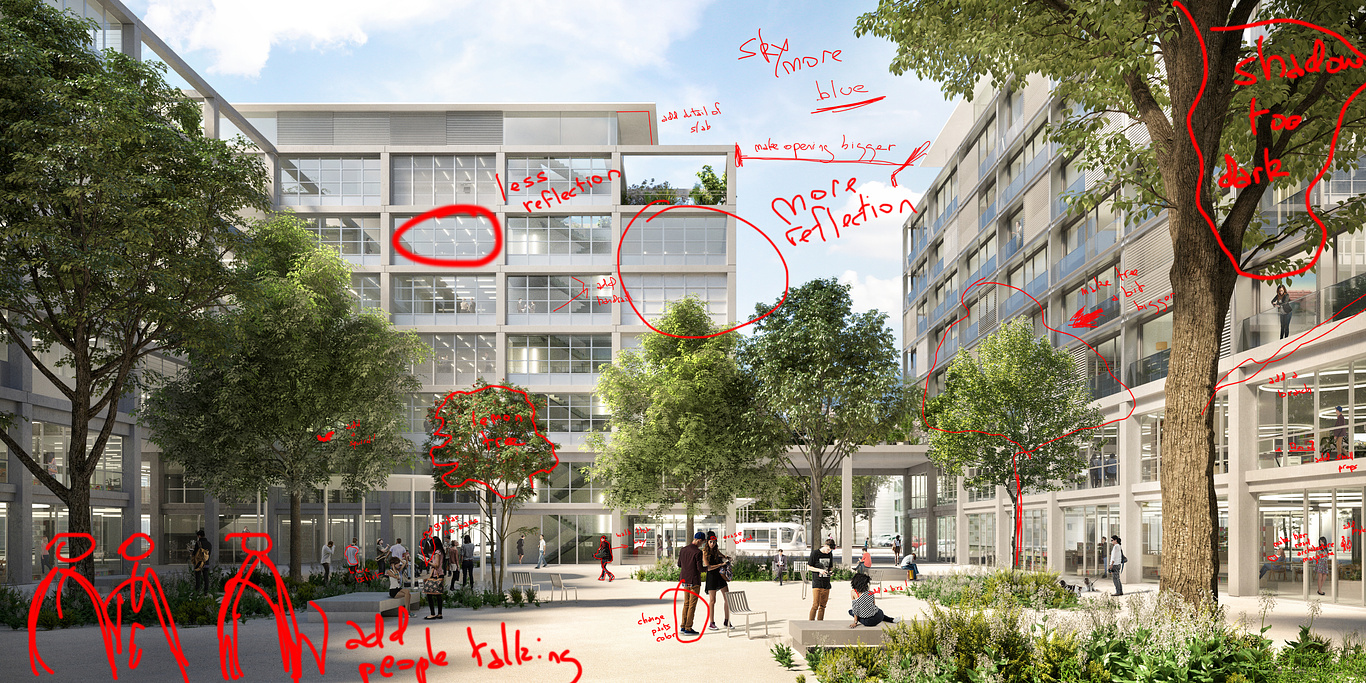
4. An image that looks good is not enough
It is often misunderstood that the feedback the architect should provide is not on the image itself but on the clarity of communication in regards to what the architect and visualizer are trying to achieve. This is why I like to differentiate a beautiful image from a successful image. Even the most beautiful image can still fail to do its job. That’s why you need to understand the key to separating a good looking image from a successful image : the clarity of intent.
Clarifying what the project is about and what you want to achieve with your architectural concept is the most important yet often overlooked step. This is where a badly executed diagnosis phase can lead to major mistakes.
When come the feedback sessions on the images you receive, the major goal is not to judge the placing of people, the colorimetry (your printers and screens are never calibered anyway), the reflectivity of the glass or the darkness of the shadows, but rather if the overall feel that you get from watching the image fits what you're trying to sell to your client.
This is why the person in charge of giving the feedback should be the person that has the best knowledge of the project and its intent, and not a mere freshly hired intern that has zero knowledge of the project but some time to spare.
Your feedback are necessary to make sure that the image makes you fall in love with the building and that the representation is true to what you're after, not fall in love with the image itself.
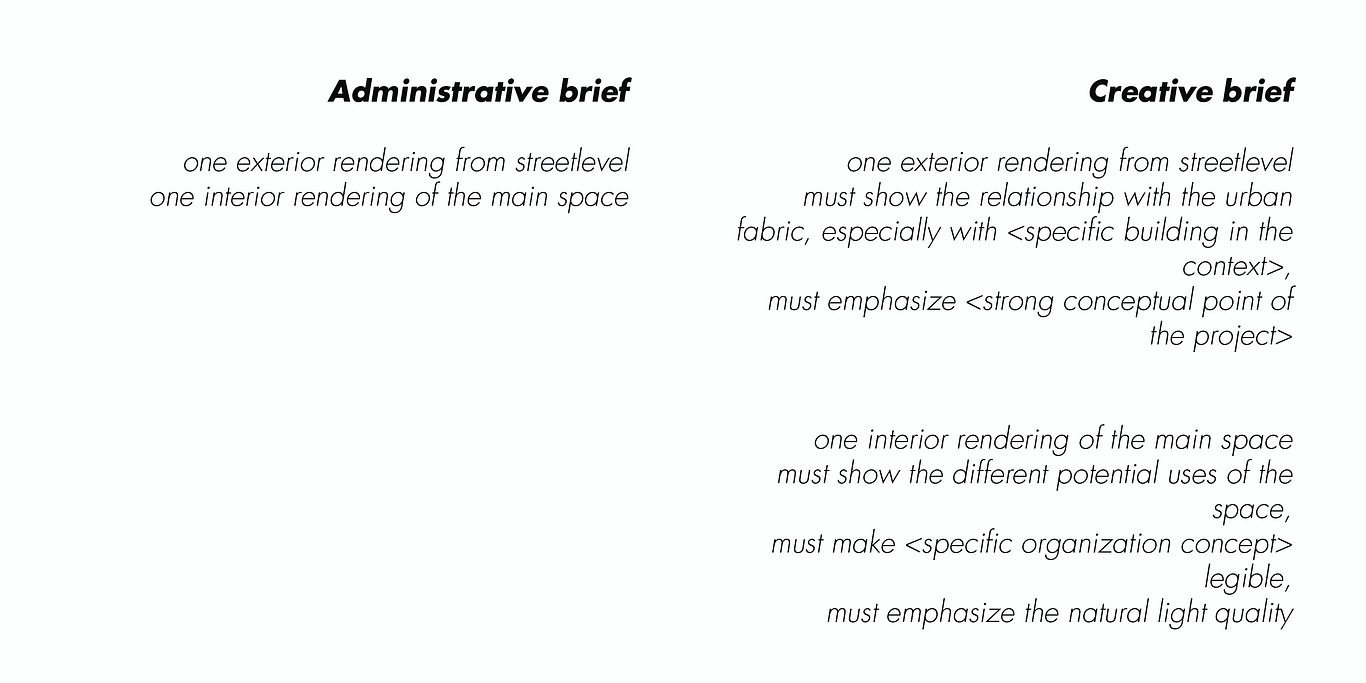
5. Don't set the brief alone
Setting the brief for the visual part of a project is a fun exercise. Or rather, it should be, because this is about building the blocks of the communication of the project you've been working on for the last weeks/months/years.
The brief is a combination of the goal you're after as well as the scope of exploration you're willing to go to in order to achieve this goal.
A common pitfall architects fall into is to self-diagnose and draw conclusion from that before even talking with the person in charge of their visual communication. It is quite common for archviz artists to have a client asking for a specific way of doing things and then discover that a more coherent and compelling approach existed but was not explored or discarded too early. The architectural equivalent is you designing a project before even meeting your client.
One of the most important topics you need to tackle quickly in the brief is how much you want to stay within the boundaries of what a viewer is expecting to see. This applies to the creative side as well as the administrative side. For the creative side, it may seem like making a visual for a school under the rain might not be the most compelling idea, but it can make sense if it fits with the intent. For the administrative side, points of view are sometimes directed by the brief of the competition organizer and don't necessarily fit your architectural parti-pris. As the architect and client, you are the only one who can decide if it is worth exploring views outside of these constraints or if it is better to stay within these boundaries. Keep in mind that often time, even though it is your own project, you're probably unaware of potential point of views that better sell the ideas you're trying to convey. This is where the expertise of the artist comes in handy.
The brief is a combination of the goal you're after as well as the scope of exploration you're willing to go to in order to achieve this goal.
A common pitfall architects fall into is to self-diagnose and draw conclusion from that before even talking with the person in charge of their visual communication. It is quite common for archviz artists to have a client asking for a specific way of doing things and then discover that a more coherent and compelling approach existed but was not explored or discarded too early. The architectural equivalent is you designing a project before even meeting your client.
One of the most important topics you need to tackle quickly in the brief is how much you want to stay within the boundaries of what a viewer is expecting to see. This applies to the creative side as well as the administrative side. For the creative side, it may seem like making a visual for a school under the rain might not be the most compelling idea, but it can make sense if it fits with the intent. For the administrative side, points of view are sometimes directed by the brief of the competition organizer and don't necessarily fit your architectural parti-pris. As the architect and client, you are the only one who can decide if it is worth exploring views outside of these constraints or if it is better to stay within these boundaries. Keep in mind that often time, even though it is your own project, you're probably unaware of potential point of views that better sell the ideas you're trying to convey. This is where the expertise of the artist comes in handy.
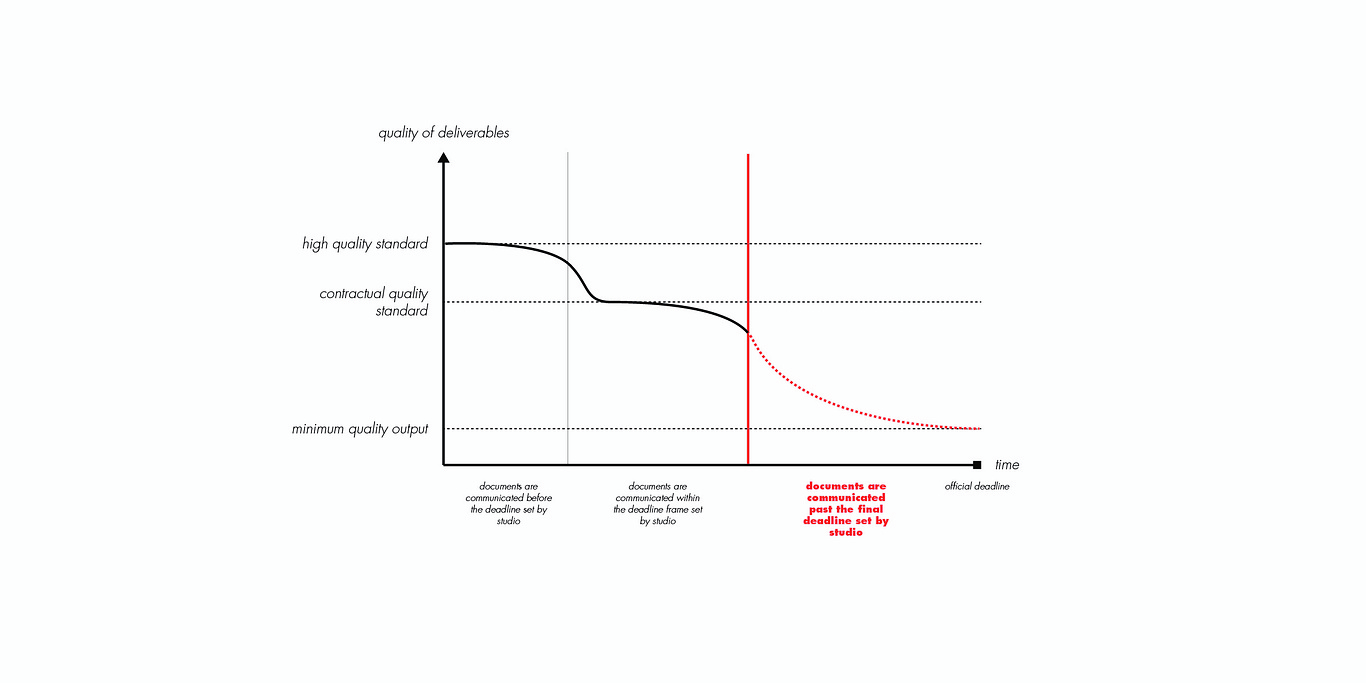
6. Poor time management is worse than you think
Time management is key. For some reason architects tend to be sadistic enough to uphold charrette as a token of the quality of work and dedication.
Besides the many counter examples, health studies and the new emerging culture of working normal hours, the main problem with poor time management is that archviz being quite down the line of documents production, it can suffer immensely and have a huge impact on the final presentation.
Usually archviz studios will give you dates for each milestones. These milestones are not there for fun, they are inherently linked to the quality of the work delivered on the final deadline.
If possible, the visual communication part should be integrated as soon as possible in the process. This can help in getting a better grip on the philosophy of the project, get decent site photos, or finetune specific spaces according to visual feedback you'd get from work in progress visualizations.
Poor time management will directly impact the final deliverables quality, but also the potential fruitful relationship you could build with the studio. Down the line, it means you'll have wasted valuable resources and potentially hurt the reputation of your studio as a collaborator.
7. Layperson vocabulary is enough for clear communication
It is an overused expression but stays true : the best way to communicate a project is to "explain your project like I'm 5". More often than not, architects will try to drop here and there some photography terms, more often than not they will be misused, and more often than not this will create confusion when it comes to actually making the images.
I'm aware some archviz artists are guilty of the same pitfall, mixing it for a token of expertise. This is not.
Sticking to simple words is enough to convey an idea across. If you need technical terms, it means you're venturing in a field where you don't need to be, because, as explained earlier what you need to focus on is the big picture and the clarity of intent, not the actual technical aspect behind these.
Generally speaking, archviz artists will be familiar with the architecture slang (the majority of them are architecture graduates, some are even practicing architecture on the side). Still I would recommend refraining from using it too much when it isn't necessary.
8. Don't rely on unproven biases
It is important to not project your own biases on your end client. We all rely on heuristics to simplify the decision-making process. The issue is, heuristics are over simplification of the real, to the point of sometimes being plain wrong.
Often time architects will ask for specific details or atmosphere in their image because of a total misconception of their client's potential expectations, generally with zero empirical evidence to back it.
It does make sense to try to anticipate what your end client will like, and it definitely is a better approach to prioritize what your client may like over what you like, but it shouldn't be a justification for ready-made approaches.
Usually, archviz consultant will be more experimented in actually assessing what an image does to the viewer and forego classic biases since part of their work involves reviewing psychology studies and the likes on image perception in order to get a more acute grasp of what a certain population will expect.
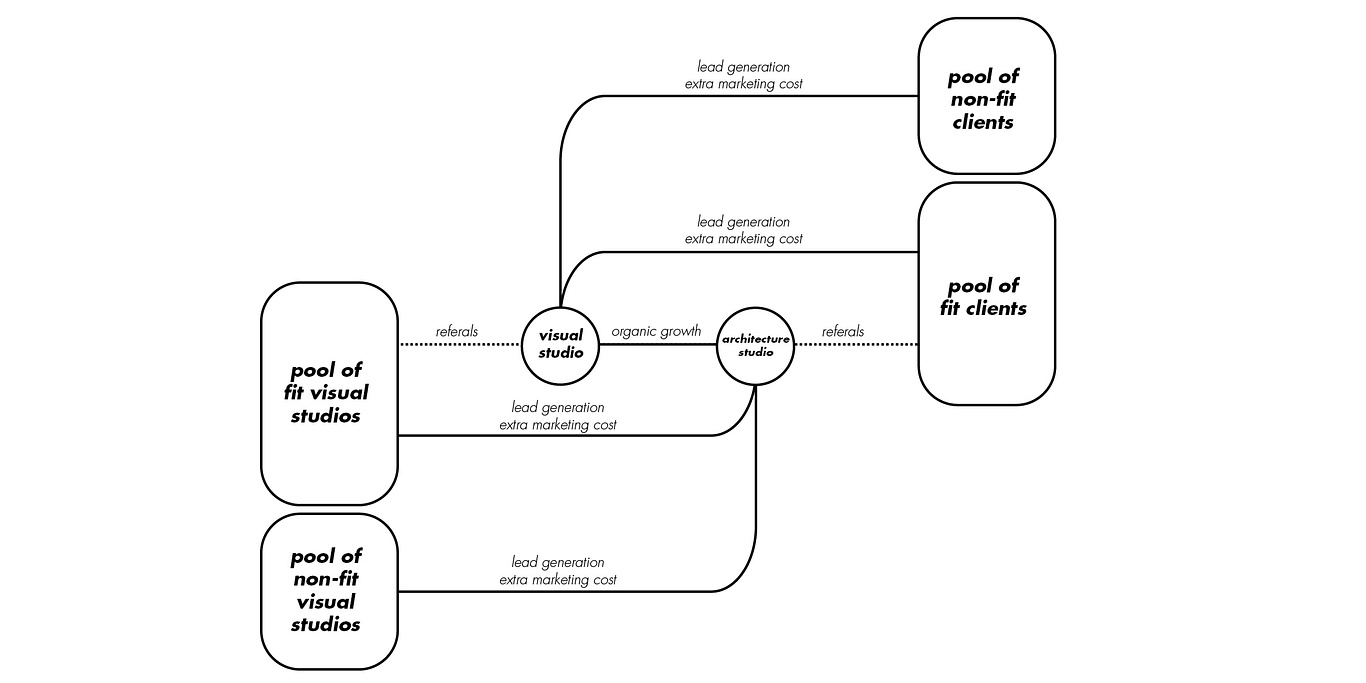
9. Keeping contractors for yourself will hurt your business
Finding a visualization studio that fits all your requirements can be hard and time consuming and it makes sense to hold onto it once you find it.
A weird practice, yet that I've found in multiple architecture firms, is to try to keep a studio for yourself and prevent as much as possible for it to work for your competitors by not referring it to any of your fellow architects.
The train of thoughts usually goes like this : if I start referring that studio to other people, they will also hire them, and they will have less time to dedicate to my firm, their price will most probably go up to a point where I can't afford it anymore, and I'll have to start searching for a new studio to work with.
What this thinking entails is slightly different,
The first major drawback of not having you refering your beloved studio to others is that it stops organic growth for it. Concretely this means it'll have to invest time and money in more active marketing.
Organic growth is also the best way to weed out unfit clients and get to work with like-minded ones.
Not getting enough work, while at first being stressful, will also be a massive obstacle to growing the studio and, above all, deepen expertise by getting experience on more diverse projects.
While expertise and experience will not follow, overall fees you're getting charged won't have any reason to go down and might actually go up to compensate for the absence of expected growth. If you seem to rely heavily on a specific archviz studio and they can't really grow how they want, they might have to charge you more eventually to compensate. Whereas, usually, when you have a steady flow of new clients you can charge more and keep your former rates for older regular clients. Some business even go as far as giving discounts to clients if they get projects through clients you sent their way.
All in all, business relationship is a two-way street. In the same way that we like getting referals from a happy client that lead to new fruitful relationships, this in turn convince us to go the extra mile to please former clients with extra services, or specific referals to other competent archviz studios when the client ask for a service we can't provide, or a deadline we can't meet.
Keeping freelancers is basically turning a win-win situation into a lose-lose one.
10. Don't pin down studios to only do images
While the core of archviz studio practice is to craft images (whether video, 360, etc), as a business relationship strengthen and thrive through time, the nature of the relationship can slide from mere image production to more tactical-oriented services.
Just like architecture practice that diversify into additional types of consulting services, archviz studio can also provide additional services to strengthen your overall visual communication.
This ranges from on-site training for your workforce (communication, branding, website revamp, stationary), interior design, workshops (software workflow, in-house editing), or dedicated sessions to finetune a specific visual style for your firm.
Generally all these consulting services come with hefty fees, but by now you should understand how visual communication is an important tool in clarifying your brand image, differentiating your firm on your market, and maximizing your time to come up with more creative solutions for your own clients.
Conclusion
I'm lucky enough to now work with architects and designers that have few or none of the above misconceptions. Working in ideal conditions like these is why I'm longing for the day when all architects will read these misconceptions with an amused smile on their face thinking no architecture firm would work like that, rather than getting annoyed because it accurately describes their current management principles. On that day I'll know business relationships will be driven by mutual interest and collaboration rather than hierarchy and ego. This seems like a pleasant future to look forward to.
You must be logged in to post a comment. Login here.
About this article
This article is first and foremost addressed to architecture firms, property developers or whatever types of clients we work with on a daily basis (hence why I'm hoping to get it published on architecture media). As in my previous article, the idea is to tackle common misconceptions that undermine the quality of the work we do as collaborators, in order to foster better communication and, down the line, better deliverables. I'd love to get your opinion and experience insight on the topic.
visibility5.38 k
favorite_border8
mode_comment6


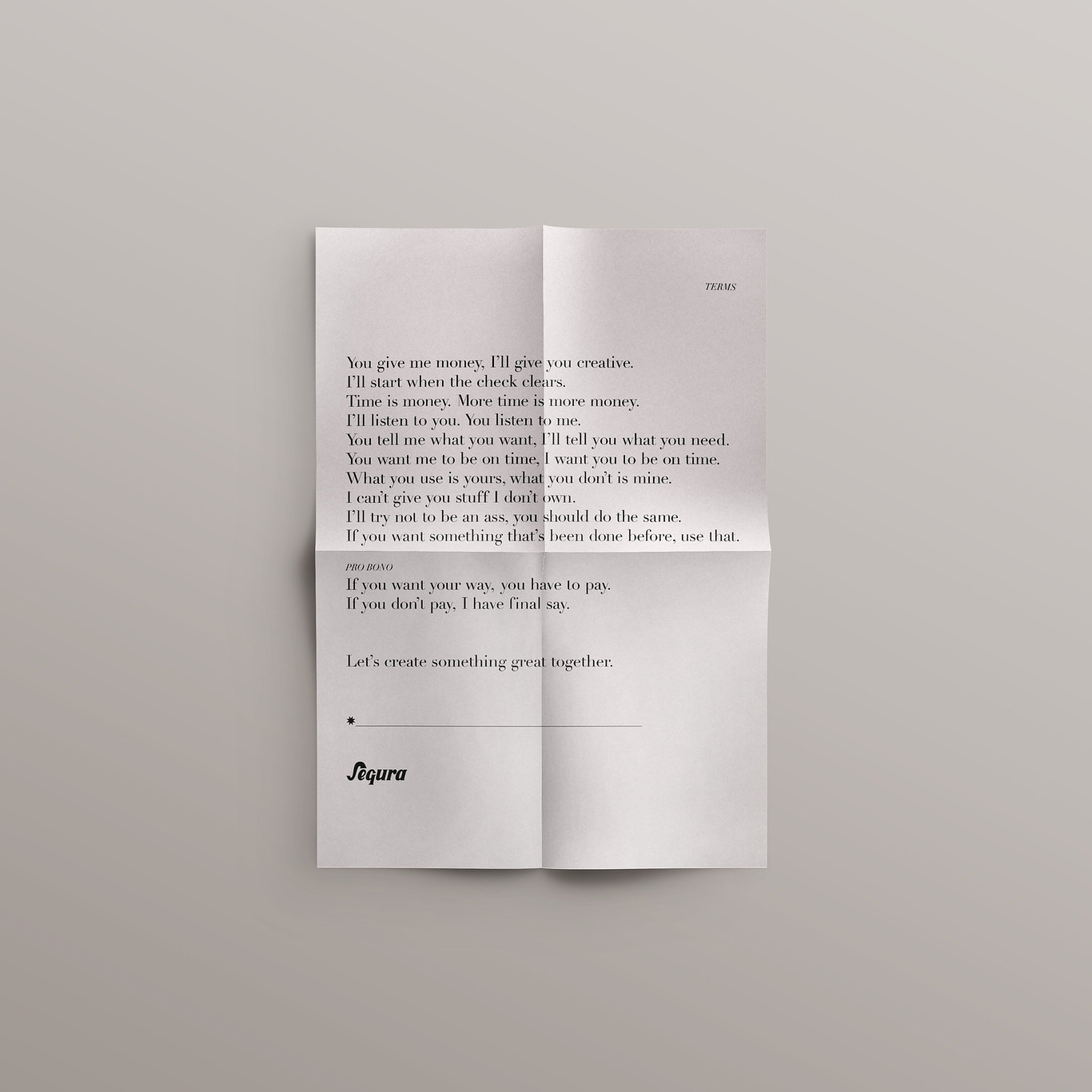
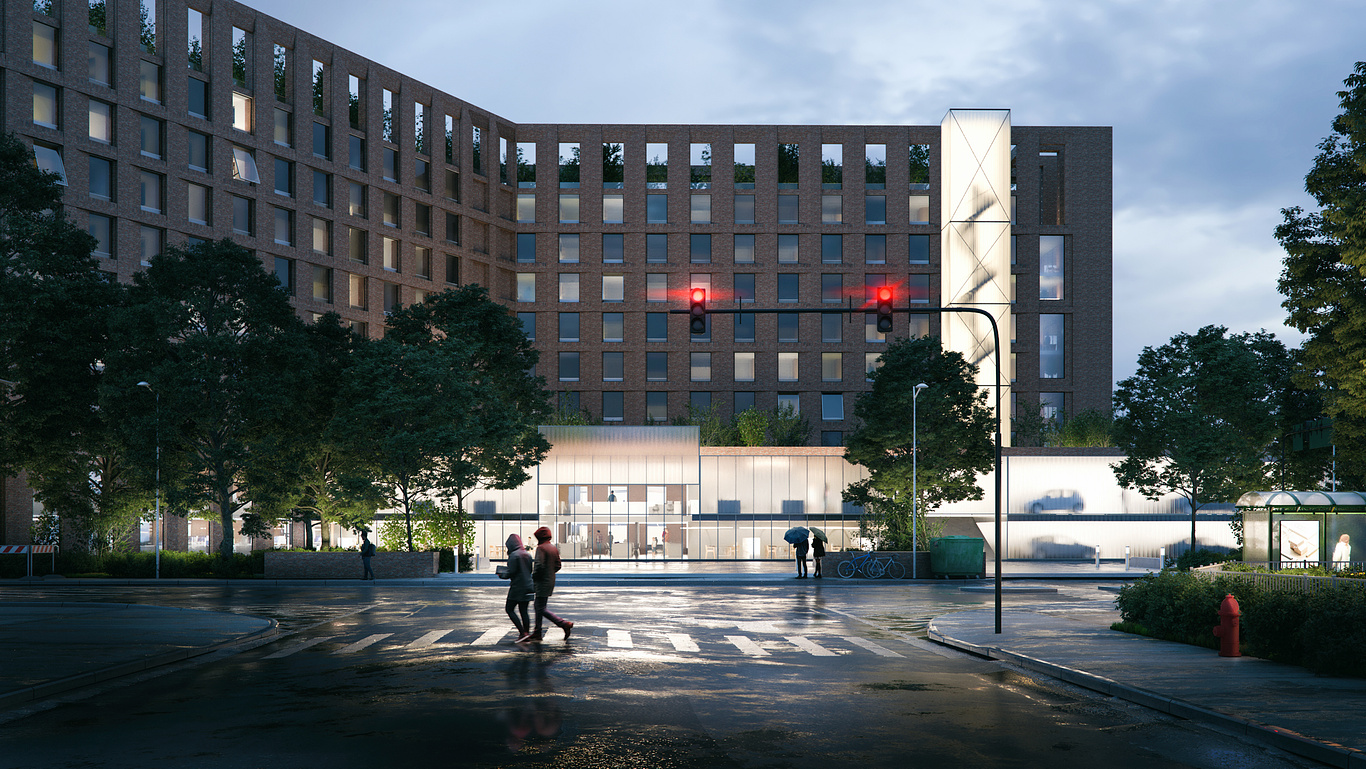
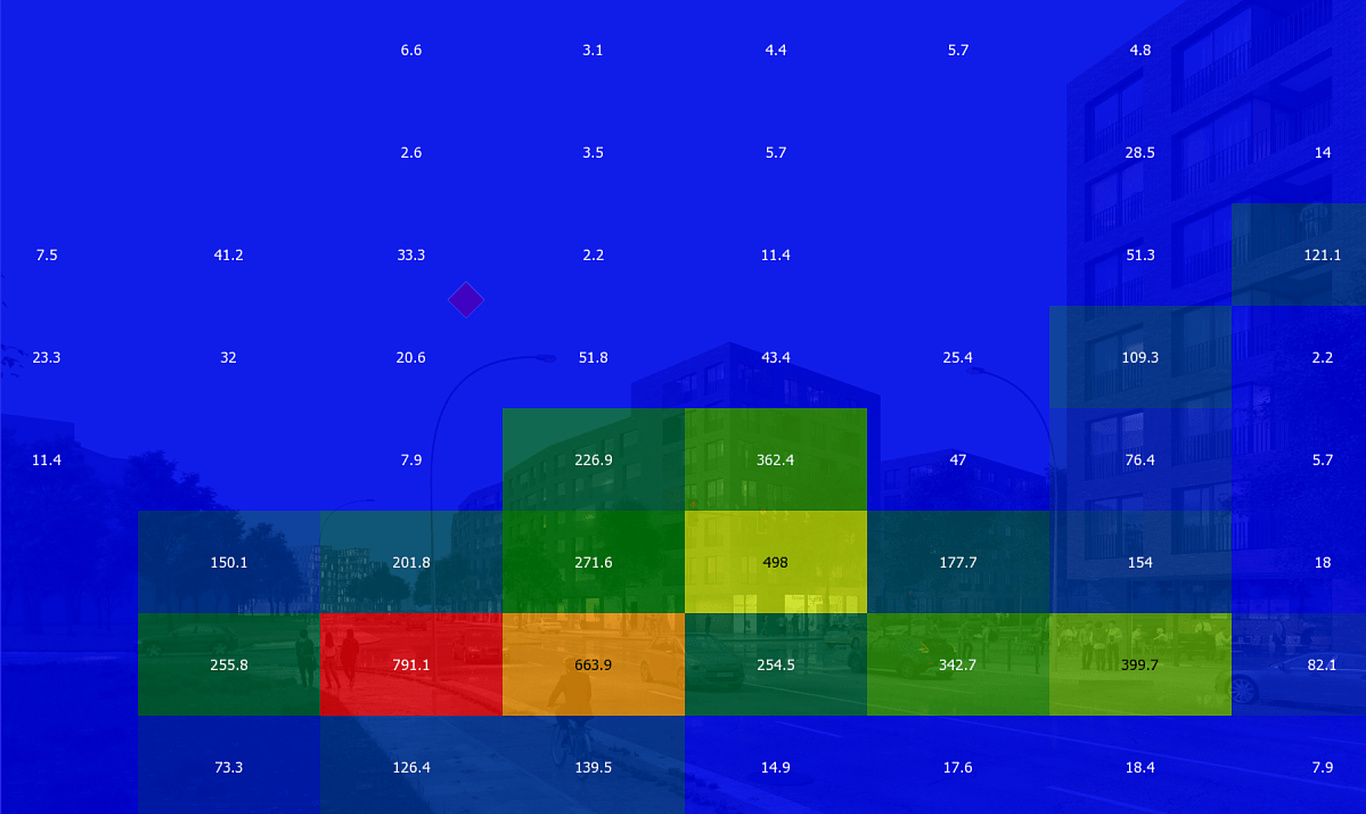




Nightnurse Images, thanks a lot :)
Hey Scott,
Glad you liked the "mirror" article too!
And thanks a lot for the kind words. This is reassuring to see you can relate to it because as you pointed out, my experience in the industry is still pretty young!
Really great article and very much to the point!
I really enjoyed reading this as well as your earlier "10 misconceptions" article. There's a lot of wisdom here, and it's impressive knowing that you have been in the industry less than 10 years! In your writing, it really comes through that you have experienced all of these issues first hand. I can certainly relate to the markup shown here on item #3. Know that you are not alone! :)
Thanks for the positive feedback, greatly appreciated :)
This was a great read, and mirrors many conversations I have had with clients and colleagues alike. Thanks for sharing